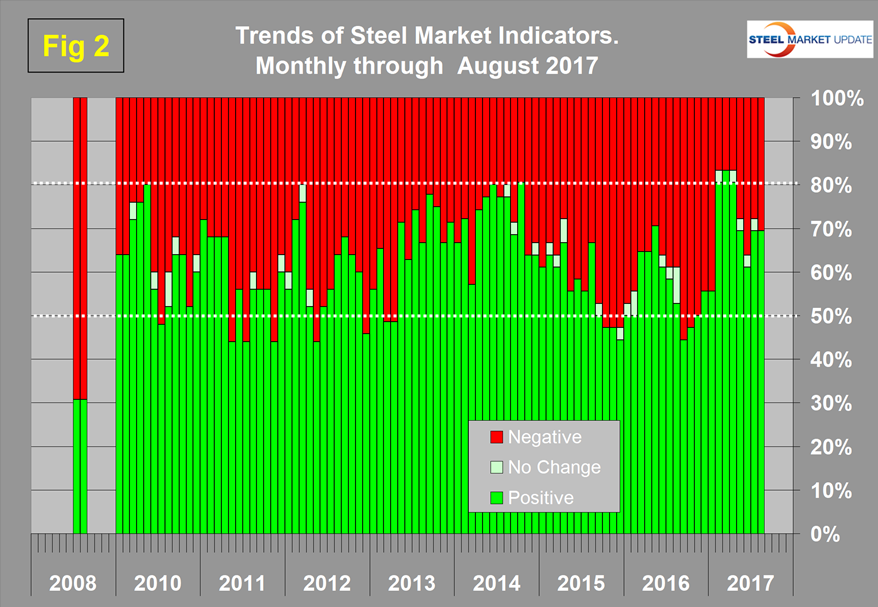SMU Data and Models

SMU Key Market Indicators Positive in August
Written by Peter Wright
August 31, 2017
Half of the 36 Key Steel Market Indicators released in August are historically positive, while only 19 percent are negative, and the balance fall within the normal range, in Steel Market Update’s view.
Along with May, when the data was about the same, this is the best outlook since we began our analysis in January 2010. Trends are still good with 70 percent of the key market indicators heading in a positive direction; this was down from 83 percent in March. Trends lead the present situation by about four months.
See the end of this article for an explanation of the Key Indicators concept. This will explain the difference between our view of the present situation, which is subjective, and our analysis of trends, which is based on the latest facts available. The total number of indicators considered in this analysis is 36.
Please refer to Table 1 for our view of the present situation and the quantitative measure of trends. Readers should regard the color codes in the present situation column as a visual summary of the current market condition. The “Trend” columns of Table 1 are also color coded to give a quick visual appreciation of the direction in which the market is headed. All data included in this table was released in August. The month or specific date to which the data refers is shown in the second column from the far right. All data is the latest available as of Aug. 31, 2017.
Present Situation
There was a net increase of one indicator that we consider to be positive in August and a decrease of one neutral. We currently view 18 of the 36 indicators as positive, 11 as neutral and 7 as negative. Our intent in using the word “neutral” is to say that this indicator is in the mid-range of historical data.
The changes in the August data releases were as follows: Log steel product shipments were re-classified from neutral to positive when they exceeded the 1.8 million ton/month threshold. The supply situation for both long and sheet steel products is the sum of mill shipments to domestic locations and imports. This is a proxy for demand, and for long products has been classed as historically positive since February. The supply of sheet has been so classed in both July and August. There were no other changes in our view of the present situation based on the data released in August.
Figure 1 shows our monthly assessment of the present situation since January 2010 on a percentage basis. The number of indicators classified as positive peaked at 47.2 percent in October 2014 and steadily declined to 11.1 percent in the three months through January 2016. Beginning in February 2016, there was a steady increase in the number of indicators we consider to be positive through May 2017, when a new high of 50.0 percent was reached. June and July declined to 47.2 percent positive with a return to 50 percent in August. The combination of positive and neutral indicators at the end of March was the highest ever at 83.3 percent. April, May, July and August were all 80 percent by this measure.
Trends
Most values in the trends columns are three-month moving averages to smooth out what can be very erratic monthly data. Trend changes in the individual sectors since the end of July are described below, together with some general comments. Note that in most cases this is not August data, but data that was released in August for previous months.
In the four months October through January, there was a steady improvement in trends. There was a positive surge in February that was sustained in March and April, followed by a significant decline in both May and June and a partial recovery in July and August. Figure 2 shows the trend of the trends and the pre-recession situation at the far left of the chart. The proportion of indicators trending positive in both the July and August data was 69.4 percent, the same as May and up from 61.1 percent at the end of June. March, at 83.3 percent, is the best result since our data was first compiled.
Our observations about trends in the August data are as follows: On Friday, the second estimate of GDP in the second quarter was released and improved from 2.6 percent to 3.0 percent. In the General Economy section of Table 1, the Chicago Fed’s National Activity Index reversed direction and trended slightly negative. There were no changes in the direction of the trends of the SMU proprietary indexes. Both continued to trend negative. The steel buyers’ sentiment has declined from its all-time high in mid-March of 74.17 to 64.3 in mid-August, but is still historically very strong (Figure 3).
Service center excess of sheet products became negative in January and grew increasingly negative through April when it reached negative 816,000 tons. This is a proprietary SMU calculation. We regard an inventory deficit to be positive in terms of pricing power; the deficit declined to 218,000 tons in July from the April level (Figure 4).
In the raw materials section, the price of Chicago shredded was unchanged in July and rose in August; therefore, there was a trend change to positive. The prices of all four raw materials that we track in this analysis increased in August. We regard rising raw materials prices as positive and indicative of a strengthening market. Trends in the long steel products sector did not fare well in the July data and improved in August when the price of rebar ex works U.S. South East reversed direction and increased by $15.50/net ton. The trends for sheet products deteriorated in the August data when three of the six indicators trended negative, a deterioration from one negative in the July data. The changes were that mill shipments declined in June on a year/year basis after increasing in May, and service center shipments declined in July after increasing in June. In the construction sector, there was one reversal when housing starts increased in June. There were no other trend changes in construction or manufacturing. In the manufacturing section, all five indicators are trending positive.
We believe a continued examination of both the present situation and direction is a valuable tool for corporate business planning.
Explanation: The point of this analysis is to give both a quick visual appreciation of the market situation and a detailed description for those who want to dig deeper. It describes where we are now and the direction in which the market is headed and is designed to describe the market on a specific date. The chart is stacked vertically to separate the primary indicators of the general economy, of proprietary Steel Market Update indices, of raw material prices, of both sheet and long product market indicators, and finally of construction and manufacturing indicators. The indicators are classified as leading, coincident or lagging as shown in the third column.
Columns in the chart are designed to differentiate between where the market is today and the direction in which it is headed. Our evaluation of the present situation is subjectively based on our opinion of the historical value of each indicator. There is nothing subjective about the trends section, which provides the latest facts available on the date of publication. It is quite possible for the present situation to be predominantly red and trends to be predominantly green, or vice versa, depending on the overall situation and direction of the market. The present situation is subdivided into: below the historical norm (-), (OK), and above the historical norm (+). The “Values” section of the chart is a quantitative definition of the market’s direction. In most cases, values are three-month moving averages to eliminate noise. In cases where seasonality is an issue, the evaluation of market direction is made on a year-over-year comparison to eliminate this effect. Where seasonality is not an issue concurrent periods are compared. The date of the latest data is identified in the third values column. Values will always be current as of the date of publication. Finally, the far-right column quantifies the trend as a percentage or numerical change with color code classification to indicate positive or negative direction.

Peter Wright
Read more from Peter WrightLatest in SMU Data and Models

SMU Survey: Sheet lead times ease further, plate hits one-year high
Steel buyers responding to this week’s SMU market survey report a continued softening in sheet lead times. Meanwhile, plate lead times have moderately extended and are at a one-year high.

SMU Survey: Buyers report more price flexibility from mills
Nearly half of the steel buyers responding to this week’s SMU market survey say domestic mills are showing increased willingness to negotiate pricing on new spot orders. This marks a significant shift from the firmer stance mills held in prior weeks.

SMU Survey: Buyers’ Sentiment Indices fall
Current Sentiment Index dropped six points to +42 this week compared to two weeks earlier. It has fallen in every successive survey since reaching a 2025 high of +66 on Feb. 19.

March service center shipments and inventories report
Steel service center shipments and inventories report through March 2024.

Apparent steel supply contracts in February
The amount of finished steel that entered the US market in February receded from January’s peak, according to our analysis of Department of Commerce and American Iron and Steel Institute (AISI) data.





